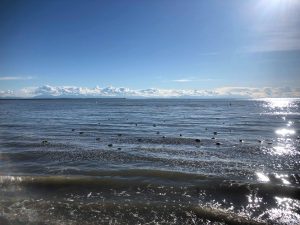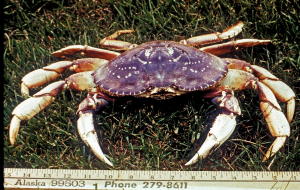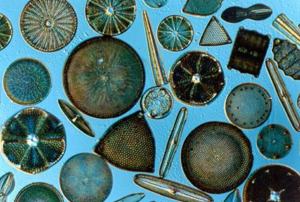
Pictured : Pacific ocean off the coast of Vancouver in the early spring with visible sea foam due to nearby logging pollution. Photo by Nela Djordjevic
Scientists have found that OA is having implications that stretch far beyond the destruction of calcium carbonate shells and skeletons. Three examples of marine organisms that have recently found to have been affected by OA are sharks, crabs, and even diatoms. From these examples, we can see that the effects can be ecological, economic, cultural, and most importantly, global!
Sharks

Pictured: Puffader Shyshark, photo from Florida Museum of Natural History
A study that looked at the puffader shyshark found that OA plays a role in degrading the sharks’ tough skin. These sharks are known to have stronger tolerance to temperature changes and pH changes due to their demersal and coastal range, so scientists tested to see how acidic conditions will affect these animals. The study found that sharks living in environments that mimicked an acidified environment showed degradation to their denticles, which are small tooth-like projections that make up their skin. They help with swimming and can lower injury risk by making skin harder and thicker. They are made of a material called dentin, which is known to be degraded by carbonic acid. Although some animals are able to adapt and remain unaffected by acidic conditions, they eventually get harmed by prolonged exposure. With rapidly increasing OA, our species cannot adapt fast enough.
Article link: https://www.sciencenews.org/article/ocean-acidification-could-degrade-sharks-tough-skin
Study link: https://www.nature.com/articles/s41598-019-54795-7
Crabs

Pictured: Dungeness Crab, photo from Wikipedia
It was recently discovered that the reduced survival of the young is due to shells dissolving and delayed sensory organ development. Sensory organ damage can alter swimming and navigation abilities, allowing them to be more vulnerable to predators. This study is important because it is the first study to ever demonstrate such results in situ, meaning that the study was done in the natural environment. The crabs were not grown in lab with artificial or expected acidic conditions. Another important aspect of this study is that it focuses on a species that has not only ecological, but also cultural and economic impact. The Dungeness crab is a popular food source for many people, and plays a huge role in the economies of coastal communities. Oregon fisheries are one of the many who have already begun to suffer from the effects of OA.
Study link: https://www.sciencedirect.com/science/article/pii/S0048969720301200
Diatoms

Pictured: Various diatoms with beautiful silica shells, photo from Plant Life
Diatoms build silica shells in order to thicken and weigh down their walls. They play an extremely important role in atmospheric oxygen and ocean carbon cycling. During large diatom blooms, they pump oxygen into the atmosphere, but when they die, they sink – thanks to their thick and heavy silica walls – and sequester carbon from the atmosphere. However, to do this, they need to be able to travel to the deep ocean. A recent study found that OA results in decreased silicification, which means that the rate that they build their silica shells with is slowed down. This results in thinner and lighter walls, which could affect their descent into deep ocean and therefore have consequences on oxygen and carbon cycles. However, the scientists state that more research needs to be done, and the exact mechanisms involved remain unknown.
Article link: https://www.sciencenews.org/article/ocean-acidification-could-weaken-diatoms-glass-houses
Study link: https://www.nature.com/articles/s41558-019-0557-y
References:
Bednarsek, N., Feely, R. A., Beck, M. W., Alin, S. R., Siedlecki, S. A., Calosi, P., Norton, E. L., Saenger, C., Strus, J., Greeley, D., Nezlin, N. P., Roethler, M., and Spicer, J. I. 2020. Exoskeleton dissolution with mechanoreceptor damage in larval Dungeness crab related to severity to present-day ocean acidification vertical gradients. Science of The Total Environment, pp. 1 – 12. doi: 10.1016/j.scitotenv.2020.136610
Dziergwa, J., Singh, S., Bridges, C. R., Kerwath, S. E., Enax, J., and Auerswald, L. 2019. Acid-base adjustments and first evidence of denticle corrosion caused by ocean acidification conditions in a demersal shark species. Scientific Reports, 9. doi: 10.1016/j.scitotenv.2020.136610
Petrou, K., Baker, K. G., Nielsen, D. A., Hancock, A. M., Schulz, K. G., and Davidson, A. T. 2019. Acidification diminishes diatom silica production in the Southern Ocean. Nature Climate Change, 9, pp. 781 – 786. doi: 10.1038/s41558-019-0557-y